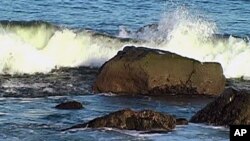In Narragansett Bay, Rhode Island, winter flounder no longer reproduce at the rate they used to. Nutrients that once supported a rich marine life are less abundant. And the water is warmer. It suffers from overfishing and shows signs of toxic chemicals banned 50 years ago. In short, say scientists at the University of Rhode Island, Narragansett Bay is typical of other coastal areas around the world.
Reinner Lohmann teaches a course in marine pollution at the University of Rhode Island. He studies organic pollutants in Narragansett Bay; specifically, the chemical contents in sediment where small organisms feed and are the start of the marine food chain. He has found hundreds of pollutants including the pesticide DDT that was banned in the United States 40 years ago. "They may be stored in the sediments, but on a nice stormy day the sediments swell up and the compounds get released back into the water and can be taken back by fish," he explained.
Lohmann says every few years the U.S. Environmental Protection Agency checks on the contaminants in fish tissue. Based on that data, government scientists establish safe eating guidelines for different fish.
The government fish advisories are based on the risk of cancer if you eat fish every day. Lohmann says humans can take 20 to 30 years to eliminate the toxics they consume when they eat contaminated fish. And long-term exposure to contaminants and the transfer of toxics from mother to child are major scientific concerns.
"We can detect these contaminants virtually everywhere," Lohmann said. "We have done studies in the Atlantic, the Arctic, in the Pacific -- they are everywhere."
Other researchers at the University of Rhode Island are studying the effects of warming water temperatures.
"One degree, it seems like nothing. But if you think back to the last glacial maximum (when the glaciers were at their thickest and the sea levels at their lowest), the change in temperature from that time until now is only five degrees celsius, or 10 degrees fahrenheit," Candace Oviatt said. Oviatt has studied the bay for more than 40 years. "So one degree is huge and we have seen huge changes on the bay as consequences of that."
Oviatt points to an 80 percent increase in rain storms. This April, large areas of Rhode Island were flooded, overwhelming several water treatment plants. Raw sewage, fertilizers and urban pollution ran freely into the bay.
"There is a lot of climate effects. One of the ones we experienced this week was this huge rain storm when we got eight inches [20.3 cm] of rain in three days," Oviatt said.
She adds that warmer temperatures in the bay and more rain water trigger a chain reaction of low oxygen and high levels of nutrients in the water, killing many organisms. "The winter flounder used to lay their eggs during the winter time because there are no predators, but if we heat up the bay waters, then those predators become active and they eat the eggs and the young juvenile winter flounder," she said.
Oviatt says overfishing and warmer waters have reduced the number of winter flounder by 75 percent. That's led to an end to commercial flounder fishing, and a two-fish limit on recreational anglers.
Yet despite the strains on Narragansett Bay, another University of Rhode Island researcher, Scott Nixon, says the bay is in better shape now than 50 years ago when metals, oils and waste often were thrown directly into the ocean. Now there are other concerns. "I think most coastal ecologists would probably say the most pervasive, chronic, widespread problem is nutrient pollution: nitrogen and phosphorus pollution that comes from agricultures," he said.
Nixon said he hopes developing countries learn from our mistakes and stop polluting their coastal areas before more damage occurs.










